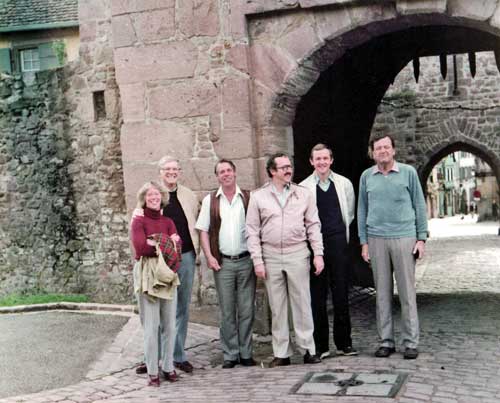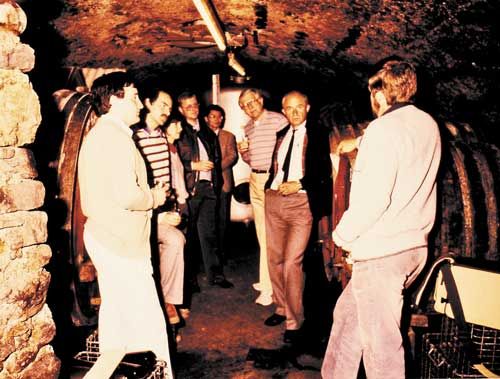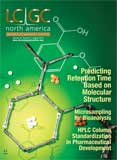Celebrating the Career of Professor Klaus K. Unger
LCGC North America
As Klaus Unger turns 80, we review his contributions to the field.
J.J. Kirkland and J.J. DeStefano spoke to LCGC about the important contributions Dr. Klaus Unger has made to chromatography as Dr. Unger celebrated his 80th birthday earlier this year.
Professor Dr.-Ing. Klaus Unger celebrates his 80th birthday this year, and it is appropriate to review the many landmark contributions he has made in two specific areas of science. Those interested in chromatography may not know that Dr. Unger’s extraordinary talents were initially directed towards the design and manufacture of porous-particle catalysts. Many important developments were made in this field, and it was not until later that he became interested in developing materials for high performance liquid chromatography (HPLC), which also needed porous particles with unique characteristics. This short article attempts to summarize Dr. Unger’s outstanding successes. The authors also attempt to offer some insight into “the human makeup” of Dr. Unger, and the strong impact he has had on other scientists.
A brief overview of Dr. Unger’s biographical background is sufficient because other publications covered this subject in detail (1,2), including a personal memoir written for LCGC (3,4). After his initial PhD training, he was on the staff at the Technical University of Darmstadt, where he also developed his habilitation. From there he moved to the University of Mainz where he was a professor at the Institute of Inorganic Chemistry and Analytical Chemistry from 1977 to 2001. From 2001 to 2009 he was a senior researcher in separations for Merck KGaA. During his career, Dr. Unger has been the author of more than 340 original publications, was editor and author or coauthor of 15 monographs, advised many graduate students, and was awarded 55 patents. He was a visiting scientist at U.S. institutions and was also a visiting professor at several European universities. Needless to say, Dr. Unger has been a very active researcher who has had an enormous impact on technical developments in both chromatography and porous catalysts.
Developments in Catalysts
Dr. Unger’s many research activities include the design, synthesis, and characterization of new adsorbents and heterogeneous catalysts. He focused particularly on methods for characterizing these porous materials by gas adsorption, mercury porosimetry, size-exclusion chromatography (SEC), and other techniques, and is recognized as a leading expert in this field. Dr. Unger’s efforts in catalysts were often directed towards mesoporous molecular sieves with silica, alumina, titania, zirconia, and aluminosilicates (5–7). Processes for preparing new zeolites (8,9) and modifying zeolites to give them superior properties (10) were especially useful. New materials based on crystalline zeo-like gallosilicate for use as catalysts and adsorbents were made by Dr. Unger (11,12). All of these and other porous materials developed for use as catalysts have had an enormous impact in the field of petroleum and related products. The subject of porous catalysts may not be of interest to chromatographers, but some of the technology Dr. Unger used in developing materials in this field is directly associated with many of his landmark contributions of porous particles used in HPLC.
Significant Contributions
Dr. Unger’s contributions to the current sophisticated state of HPLC technology are so numerous and varied that it seems only practical to emphasize the ones that are regarded by us to have made the most impact. Of special note was the preparation of organically modified silicon dioxide particles (13). While these particles were never commercialized, they formed the basis for the extensive and highly successful hybrid particles that were later developed commercially by others. These hybrid materials have had a strong impact on the methods that are used globally to perform separations in a widely diverse range of applications. Dr. Unger’s work on synthesizing and characterizing sub-2-µm solid silica particles has been especially important because these materials formed the basis for the currently widely used superficially porous (core–shell) particles for HPLC that have solid cores and thin porous outer shells (14,15). These particles have now become the workhorse materials for HPLC and ultrahigh-pressure liquid chromatography (UHPLC) separations for both small and large molecules (16,17).
Dr. Unger’s landmark papers on bonding silanes to silica was important for developing technology to create stable stationary phases for chromatographic column packings (18,19). Many manufacturers have used his ideas to produce commercial columns that are available globally. The development of monolithic columns for HPLC was greatly enhanced by Dr. Unger’s studies in this area (20,21). Columns of these materials are now widely used for separations throughout the world.
Of special interest is the work that Dr. Unger did to develop capillary electrochromatography (CEC) (22–24). While this powerful separation method has not reached the same level of prominence as HPLC, the critical studies by Dr. Unger have been highly influential in positioning CEC in terms of utility and potential applicability for the high-resolution separation of both small molecules and larger species, such as peptides.
Dr. Unger’s efforts in the separation of biological compounds were a natural extension of his versatile talents. Basic studies produced critical information on the separation of peptides and proteins with monolithic columns (25). He was an early adopter of the application of multidimensional HPLC for protein separations (24,27), and, for example, developed equipment and techniques for the automated multidimensional sample preparation and identification of peptides in human blood and urine (28). Dr. Unger was particularly active in the design of functionalized adsorbents for the HPLC–mass spectrometry characterization of peptides and proteins (29).
The impact of the books written by Dr. Unger and their influence on the development of column packings for HPLC can never be underestimated. The monograph on porous silica (30) and a handbook of HPLC (31) were practical and widely acclaimed for their technical quality and utility.
Personal Insights
Recognition of Dr. Unger would not be complete without an attempt to present his unique personal qualities. The authors have known and worked with him for many years, and this may qualify us to present his personal characteristics. He is widely known for his upbeat, friendly manner that rapidly engages people in many subjects. Dr. Unger is always forthright, exacting, and a model of intellectual honesty. He enjoys interacting with people and has a special manner in reaching out so that confidence is quickly acquired. His positive manner is light and humorous, and his respect for all (especially young students) is well known.
Dr. Unger is known as a consummate organizer of social functions because he knows all the best addresses for food and wine in Europe and worldwide. Figure 1 shows a group of Unger-organized prominent chromatographers at a “preconference” social outing before the 1987 HPLC Symposium in Baden-Baden, Germany. Dr. Unger had arranged this outing to a 16th-century town, Recqhuir, France, because of his knowledge of a unique hotel with an outstanding chef.

Figure 1: Social gathering of chromatographers arranged by Professor Unger in 1987. Left to right (affiliation as of that time): Karin M. Kirkland, Zeneca Pharmaceuticals; Dr. J. Jack Kirkland, DuPont Company; Dr. Johan Kraak, University of Amsterdam, Netherlands; Professor Milton Hearn, Monash University, Australia; Dr. Bengt-Arne Persson, Astra Pharmaceuticals, Sweden; and Professor Goren Schill, Upsalla University, Sweden. Photographer: Professor K.K. Unger.
Dr. Unger is not only an outstanding chromatographer, but also an expert of fine wines. Part of this was a result his co-ownership of a Riesling vineyard and winery on the Rhine River. In Figure 2 a group of chomatographers are shown unsuccessfully trying to consume the contents of a 200-gallon cask of Riesling stored in this winery. Needless to say, that mobile phase flowed actively during this process, and even some technical discussion took place.

Figure 2: In Klaus Unger’s vineyard cellar, 1985. Left to right (affiliation as of that time): An unidentified person; Professor A.M. Lenhoff, University of Delaware; an unidentified person; Dr. Jurgen Kohler, Max Planck Institute, Germany; Professor N. Tanaka, Kyoto Institute of Technology, Japan; Dr. J. Jack. Kirkland, DuPont Company; Professor K.K. Unger, University of Mainz, Germany; and an unidentified person.
J.J. DeStefano will never forget his first meeting with Dr. Unger in 1980. On a business trip to Germany for the DuPont Company, he was greeted at Frankfurt airport by Dr. Unger who packed him into his Mercedes car and quickly (at over 150 km/h) drove him to a wooded area outside of the city where he said he would show him his “first” HPLC column. Dr. Unger put on his hiking boots, and they began walking through a heavily wooded and muddy area. DeStefano was still dressed for more formal travel and nearly ruined his shoes. Eventually they came across the “column” (see Figure 3). It turned out to be a remnant of a Roman ruin, which Dr. Unger gloriously liked to show off to his chromatography friends. This episode turned out to be one of many hiking treks taken with Dr. Unger over the years. His love of the outdoors is legendary and is the source of many happy memories.

Figure 3: Dr. Unger’s “column,” 1980.
Klaus Unger has long been a friend of J. Jack Kirkland and his family. Jack Kirkland can pleasantly remember “Uncle Klaus” taking Kirkland’s two 4- and 5-year-old children hand-in-hand down to the ocean beach at the Outer Banks in North Carolina many years ago.
Dr. Unger has unfailingly lent himself to the support of chromatographically based organizations of all types. He chaired the HPLC Symposium at Munich in 1999, and was one of the early organizers of the International Symposium on Peptide, Protein, Polynucleotides, which is still actively ongoing. J.J. DeStefano worked with Dr. Unger within this organization for many years, which benefited from his experience and wisdom in reaching those interested in the separation of biomolecular compounds. Dr. Unger has taught many HPLC courses on different subjects throughout the world, passing on to students the many experiences that he has acquired in his busy career. Lastly, he has assisted many students who have gone on to have fruitful and productive careers in both industry and academia. This latter accomplishment may reflect the most lasting and productive feature of his illustrious career.
Happy Birthday Klaus!
References
- C.W. Gehrke, Chromatography: A Century of Discovery 1900–2000 (Elsevier, 2001).
- Wikipedia, Klaus Unger, from: Editor, Chromatographia63, 521 (2006).
- K.K. Unger, LCGC North Am. 29(4), 326–336 (2011).
- K.K. Unger, LCGC North Am. 29(8), 658–666 (2011).
- U.S. patent 6,645,461, 11 November 2003.
- K. Schumaker, C. du Fresne von Hohenesche, K.K. Unger, R. Ulrich, A. du Chesne, U. Wiesner, and H.W. Speiss, Advan. Mater.10, 1194–1198 (1999).
- M. Grun, I. Lauer, and K.K. Unger, Advan. Mater. 10, 254–257 (2004).
- U.S. patent 5,385,714, 31 January 1995.
- A. Tisler, K.K. Unger, and F.F. Schueth, Zeolites18, 232 (1997).
- U.S. patent 5,133,952, 28 August 1992.
- U.S. patent 5,273,737, 12 December 1993.
- U.S. patent 5,409,687, 25 April 1995.
- U.S. patent 4,017,528, 12 March 1997.
- U.S. patent 4,775,520, 4 October 1988.
- U.S. patent 4,911,903, 4 October 1988.
- V. Gonzalez-Ruiz, A.I. Olives, and M.A. Martin, Trends Anal. Chem. 64, 17–28 (2015).
- S.A. Schuster, B.M. Wagner, B.E. Boyes, and J.J. Kirkland, J. Chromatogr. A1315, 118–126 2013).
- J.N. Kinkel and K.K. Unger, J. Chromatogr. 316, 193–200 (1884).
- K.D. Lork, K.K. Unger, and J.N. Kinkle, J. Chromatogr.352, 199–211 (1986).
- K.K. Unger, R. Skudas, and M.M. Schulte, J. Chromatogr. A1184(1–2), 393–415 (2008).
- R. Skudas, B.A. Grimes, M. Thommes, and K.K. Unger, J. Chromatogr. A1216, 2625–2636 (2009).
- K.K. Unger, M. Huber, K. Walhagen, T.P. Hennessy, and M.T.W. Hearn, Anal. Chem.74, 200A–2007A (2002).
- M.I. Huber, T.P. Hennessy, D. Lubda, and K.K. Unger, J. Chromatogr. B803, 137–147 (2004).
- U.S. patent 5,858,241, 12 January 1999.
- R. Skudas, B.A. Grimes, E. Machtejevas, V. Kudirkaite, O. Kornysova, T.P. Hennessy, D. Lubda, and K.K. Unger, J. Chromatogr. A1144, 72–84 (2007).
- K.K. Unger, K. Racaityte, T. Miliotis, L.E. Edholm, R. Bischoff, and G. Marko-Varga, J. High Res. Chromatogr. 1002, 259–265 (2000).
- K. Wagner, K. Racaityte, K.K. Unger, T. Miliotis, L.E. Edholm, R. Bischoff, and G. Marke-Varga, J. Chromatogr. A893, 293–305 (2000).
- E. Machtejevas, H. John, K. Wagner, L. Standker, G. Marko-Varga, W.-G. Forssmann, R. Bisschoff, and K.K. Unger, J. Chromatogr. B803, 121–130 (2004).
- K.K. Unger and B. Anspach, Trends Anal. Chem. 6, 121–125 (1987).
- K.K. Unger, Porous Silica (Elsevier, Amsterdam, The Netherlands, 1979).
- K.K. Unger, Handbook of HPLC, Part 1 (GIT Verlag, 1989).
Joseph J. Kirkland gained his PhD in analytical chemistry from the University of Virginia and performed research at DuPont for 40 years. He is best known for his 50 years of work in HPLC, having produced eight books, >160 papers, and 36 patents. He has received many international awards for his work, and is now Vice-President, R&D for Advanced Materials Technology, Inc.
Joseph J. DeStefano is the cofounder and President of Advanced Materials Technology, Inc., following a career with the DuPont Company, Rockland Technologies, and Agilent Technologies in a variety of technical and managerial positions. He is the author or coauthor of more than 50 technical articles on HPLC columns and packing material technology for the separation of small and larger molecules of pharmaceutical or biological interest.

New TRC Facility Accelerates Innovation and Delivery
April 25th 2025We’ve expanded our capabilities with a state-of-the-art, 200,000 sq ft TRC facility in Toronto, completed in 2024 and staffed by over 100 PhD- and MSc-level scientists. This investment enables the development of more innovative compounds, a broader catalogue and custom offering, and streamlined operations for faster delivery. • Our extensive range of over 100,000 high-quality research chemicals—including APIs, metabolites, and impurities in both native and stable isotope-labelled forms—provides essential tools for uncovering molecular disease mechanisms and exploring new opportunities for therapeutic intervention.
New Guide: Characterising Impurity Standards – What Defines “Good Enough?”
April 25th 2025Impurity reference standards (IRSs) are essential for accurately identifying and quantifying impurities in pharmaceutical development and manufacturing. Yet, with limited regulatory guidance on how much characterisation is truly required for different applications, selecting the right standard can be challenging. To help, LGC has developed a new interactive multimedia guide, packed with expert insights to support your decision-making and give you greater confidence when choosing the right IRS for your specific needs.

.png&w=3840&q=75)

.png&w=3840&q=75)



.png&w=3840&q=75)



.png&w=3840&q=75)









